Our story
This Chapter
Dawn of history
School days
Juvenile behavior
A farmer's handbook
Use of shade-trees
and the wrath of a goddess
Crafty state craft
Laying down the laws
Morality and the lack theref
Slavery
Proverbs
Fashions
Bibliography
Temper
Footnotes
|
|
"History will be kind to me for I intend to write it" February 10, 2015  The messenger's mouth was heavy, he could not repeat the message. The Lord of Kullab patted some clay, he put the words on it as on a tablet. Before that time, words put on clay had never existed. Enmerkar and the Lord of Aratta [~1800 BCE] 3 Sumerians invented writing around 3500 BCE, that is well before this snippet of history was put on clay. Initially it took on the form of logograms, little pictures, which over time evolved into letters. The letters seen here were made by a reed, cut for the purpose of making these markings on clay tablets. This type of script is known as cuneiform (meaning "wedge shaped") and has since been used by other peoples, speaking other tongues, notably Akkadian: 4  ... remedies from the top of the head to the toenails, non-canonical selections, clever teachings, whatever pertains to the medical mastery of Ninurta and Gula, I wrote on tablets, checked and collated, and deposited within my palace for perusal and reading. Colophon on medical text, library of Ashurbanipal [ruled Assyria 668–627 BCE]. 5 That Sumerian snippet is taken from a poem about the hero Enmerkar who lived in the city-state Erech many centuries before it was written. Enmerkar had an eye on the riches of another city-state, Aratta, and wished it to become a vassal-state to Erech, thereby extracting a rich tribute in the form of gold, silver, lapis lazuli and precious stones, and the building for him varous shrines and temples. Being the son of the sun-god Utu, Enmerkar sought help of his sister Inanna, the powerful goddess of love and war. He then, instead of unleashing a war, threatened Aratta with utter destruction. A messenger went back and forth between the two cities, and it was on one of these occasions that he got tongue-tied. For that reason t was, wrote to the poet, that Enmerkar, the Lord of Kullab, put words on a clay tablet. 6 The story is told in far more detail by Sumerologist Samuel Noah Kramer († 1990) in his wonderful book History begins at Sumer (1956). He presents this "war of nerves" as one of some 39 "firsts" in human history, collectively making a strong connection between the way people thought and acted more than 50 centuries ago and in the present. Sure, we see lots and lots differences when focusing on finer details, but in this broadwe overview really not all that much. Our genealogy seeks to grasp why we think they way we do and this one-chapter historical stop-over in Sumer tends to affirm what evolutionary psychologist Barkow wrote: "beneath new culture is old psychology." History permits us to look at details whereas prehistory is still mostly patches in the undergrowth. In this chapter, I ll unashamedly crib from the writings by Kramer, but do yourself a favor if you can find the time: read the book! 7 Schools are a good place to start. They had teachers, teaching assistants, management, disciplinarians, writing materials. Students, we know, were boys from the upper classes of society. The subjects? Reading and 'riting and 'rithmetic, apparently taught to the tune of something akin to a hick'ry stick. But no sign of girls going to school. Thousands of fragments of clay tablets have been found that show exercises in writing, student exercises in copying material prepared by their masters. It was tough sledding, schooldays lasted from sunrise to sundown. Records have been found not only listing students, but also the status of their fathers. Schools not only taught reading and writing, but thereby also subject matter. A typical schoolday: reciting a tablet, eating lunch, preparing a tablet and writing on it, receiving assigments for oral and written work. And the masters, over time, contributed to improving the script for greater ease and utility, shifting from logograms to characters. 8 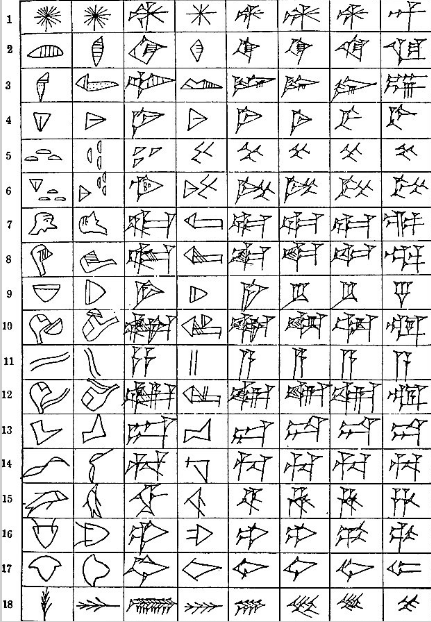 Origin and development of the cuneiform of writing, from about 3000 BCE to about 600 BCE. Legend: 1. heaven, god; 2. earth; 3. man; 4. pudendium, woman; 5. mountain, land; 6. slave-girl; 7. head; 8. mouth, to speak; 9. food; 10. to eat; 11. water, in; 12. to drink; 13. to go, to stand; 14. bird; 15. fish, may; 16. ox; 17. cow; 18. barley. (Source: the book by Kramer.) 9 Written language was the product of an agrarian society, centered on growing grain. A natural result is the production of beer; not surprising, therefore, that some of the very oldest written inscriptions concern the celebration of beer and the daily rations alotted to each citizen.* 11 Where their are masters and pupils, there is apple polishing. A story written by a teacher around 2000 tells us about a schoolboy who, afraid of the caning that awaits him for coming late, tells his mother to hurry up with making his lunch. Boy got caned for the slightest indiscretion: talking, standing up.... It just became too much for one boy; he suggested his father invite the teacher over and mollify him with some presents—the first recorded case of apple polishing. 12 Juvenile delinquency was a problem then as well as today. A father admonishes his son,"You who wander about in the public square, would you achieve success? Then seek out the first generations. Go to school; it will be of benefit to you. My son, seek out the first generations, inquire of them. Perverse one over whom I stand watch—I would not be a man if I did not stand watch over my son. I spoke to my kin, compared its men, but found none like you among them.... Others like you support their parents by working. If you spoke to your kin, and appreciated them, you would emulate them. They provide 10 gur (72 bushels) barley each .... But you, you're a man when it comes to perverseness, but compared to them you are not a man at all." 13 Let's hope this father had more luck with his son. A clay document dating back to about 1800 BCE begins, "In days of yore, a farmer gave (these) instructions to his son." Consider it the first known treatise on forming. When the land is irrigated, care must be taken that the water does not rise to high over the field and when the water subsides, the wet ground must be carefully guarded against trampling animals; the field must be cleared of weeds and stubble, and it must be fenced in. And so on. Truly a handbook and one that also gives us an insight into the farming tools available and how to use them. 14 Another clay tablet tells us about shade-tree gardening and the why of it: to protect the plants from wind and sun. The instructions are woven into a myth of crime and punishment. A farmer raped the goddess Inanna while she was asleep. For punisment she filled all the wells of the land with blood so that all the palm groves and vinyards became saturated with it. And she sent destructive winds and storms against the land. There was a third punishment as well, but the tablet was too fragmentary to enlighten us about that one. The interesting part is that the story is reminiscent of the punishments meeted out to an Egyptian pharao for not letting the Israelis go. Our next chapter will provide more parallels between Sumerian myths and stories the Bible tells us. 15 A "first" in state craft: a bicameral congress, about 3000 BCE Elders made up the one party; arms-bearing male citizens th other. At issue: war or independence. The conservatively cautious elders declared for peace; the armed citizens declared for war and freedom. The king wasn't amused by the elders' choice and this time brought the matter for an combined assembly. The decision then went in favor of going to war. All this happened in Erech, which was threatened by another city-state, Kish. Erech's king was Gilgamesh, the hero of the oldest literature now extant. The story is told in an epic poem of which this part translates as: 16 The envoys of Agga, the son of Enmebaraggesi, Another "first" in state craft: a tax reduction. This first case of social reform occurred in the Sumerian state Lagash, in the 24th century BCE It served to correct abuses by an ubiquitous bureaucracy. The Lahgahites felt so victimized that they threw off their old Ur-Nanshe dynasty and selected another ruler, Urukagina. The new ruler restored law and order and established the freedom of his citizens. History was kind to Urukagina: the story has been told by his own archvists to commemorate the dedication of a new canal. Kramer tells us, "Nominally the city of Lagash, like the other Sumeran city states [at that time], was under the overlordship of the king of the entire land of Sumer. Actually its secular ruler was the ishakku, who ruled the city as the representative of the tutelary deity to whom, in accordance `with the Sumerian world view, the city had been allotted after the creation.... By and large, te inhabitans of Lagash were farmers and cattle-breeders, boatmen and fishermen, merchants and craftsmen. Its economy was mixed—partly socialistic and state-controlled, and partly capitalistic and free. In theory, the soil belonged to the city god, and therefore, presumably, to his temple, which held it in trust for all its citizens. In actual practice, while the temple corporation owned a great deal of land, which it rented out to some of the people as sharecroppers, much of the soil was the private property of individual citizens. Even the poor owned farms and gardens, houses and cattle. Moreover, because of Lagash's hot, rainless climate, the supervision of the irrigation projects and waterworks, which were essential to he life and welfare of the entire community, necessarily had to be communally administered. But in many other respects the economy was relatively free and unhampered. Richess and poverty, success and failure, were, at least to some extent, the result of private enterprise and individual drive." 18 We shall encounter much of these types of events in "Europe's" feudal system, the subject of Chapter 20, which just goes to show that the way people think and act does not change much over a long stretch of time. Apart from the word "socialism," the story lines up well with much of our modern western world's republican/conservative mode of thought. Which is my reason for the previous paragraph's extensive quote. 19 But back to the Lagash story. Lagash's rulers had great ambitions in the directon of empire building. Initially victorious, their enemies eventually got the better of them and Lagash became weak and prey to being subjected by others. The defense of Lagash required ever more resources and the bureaucracy kept on raising the taxes of the citizens and began appropriating temple property. All this went on after the external threat had subsided; the bureaucrats kept enriching themselves. The citizens rebelled and Urukagina stepped in and turned he tide by relieving them from excessive economic burdens, like a lowering of taxes. 20 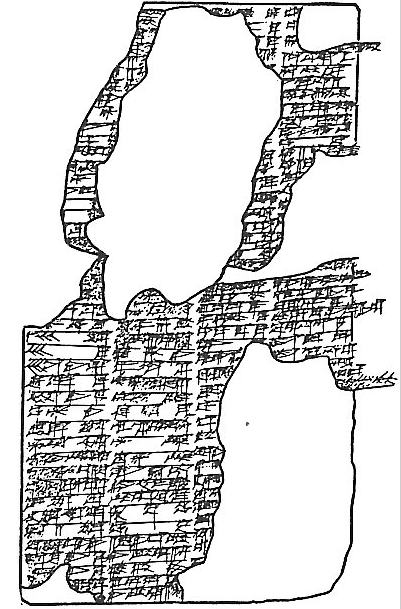 Tablet with the earliest law code known— obviously not in its entirety. The picture illustrates what Sumerologists are up against when trying to make sense of the fragments dug up, chiefly at Lagash. The code was created under the Sumerian ruler Ur-Nammu, who lived around 2050 BCE or earlier still. (From Kramer's book.) 21 Tablet with the earliest law code known— obviously not in its entirety. The picture illustrates what Sumerologists are up against when trying to make sense of the fragments dug up, chiefly at Lagash. The code was created under the Sumerian ruler Ur-Nammu, who lived around 2050 BCE or earlier still. (From Kramer's book.) 21Didn't we learn in school that the Babylonian ruler Hammurabi's lasting achievement is his law code, and that it was the first written law code ever? Well, no longer. Today, the earliest law code known goes back to 2100 BCE, or earlier still. That makes it at least 300 years older than Hammurabi's. Yes, Moses' Ten Commandments would be older still, but that is a different cattle of fish. 22 Quoting Kramer: "After the world had been created, and after the fate of the land Sumer and of the city Ur had been decided, An and Enlil, the two leading deities of the Sumerian pantheon, appointed the moon-god Nanna as the king of Ur. One day, Ur-Nammu was selected by the god to rule over Sumer and Ur as his earthly representative. The new king's first acts had to do with the political and military safety of Ur and Sumer. In particular he found it necessary to do battle with the bordering city-state of Lagash, which was expanding at Ur's expense. He defeated and put to death its ruler, Namhani, and the, 'with the power of Nanna, the king of the city,' he reestablished Ur's former boundaries. 23a Now came the time to turn to internal affairs, and to institute social and moral reforms. He removed the 'chiselers' and the grafters, or as the code itself describes them, the grabbers of the citizens' oxen, sheep, and donkeys. He then established and regulated honest and unchangeable weights and measures. He saw to it that 'the orphan did not fall prey to the wealthy'; the widow did not fall prey to the powerful'; the man of one shekel did not fall prey to the man of sixty shekels'." 23b Because of damage, only five laws can be restored with some degree of certainty. "One of them seems to involve a trial by water ordeal; another seems to trat of a slae to his master. But it is the other threelaws, fragmentary and difficult as their contents are, that are of very special importance for the history of man's social and spiritual growth. For they show that, even before 2000 BCE, the law of 'eye for eye' and 'tooth for tooth'—still prevalent to a large extent in the Biblical laws of a much later day—had already given way to the far more humane approach in which a money fine was substituted as a punishment." What brought this enhanced hunaness about? I have no idea, but I suspect that the wealthier upper crust preferred to pay a fine they could afford over other punishments. Or, maybe, the thought struck people, "there, but for the grace of *, go I." 23c Many tablets have been found that show that advanced students devoted much schooltime to matters of law. It appears again that we are en route to the answer for the question "why do we, or what makes us, think the way we think." 24 Ethics was big with the Sumerians, even though there were plenty of bad eggs among them. How little has changed over the last 60 centuries! Well, not quite: there were no nice Heaven or Walhalla awaiting them after dead. We are told Sumerians believed that mortals were there simply for the pleasure of the gods, to serve them, to provide them with food, drink and shelter so that they might have full leasure for their divine activities. The dead were disposable, their spirits descending into a dismal neitherworld. Free will was something unheard of there and then. Any divine punishment was meeted out during life, not after. Man, it appeared, was a plaything of the gods and the world was the way it was and had always been ever since creation. By and large, anyway. Nevertheless, there was a goddess of the dead, Inannu's older sister Ereshkigal. 25 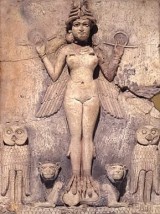 Ereshkigal, "great lady under earth," goddess of the neitherworld. Despite her looks, she was ugly inside. One myth tells us about Inanna going down to pay respects to her sister. She was to shed a piece of clothing when passing each one of some seven gates and that, when she finally made it, she was killed and strung up from a hook behind Ereshkigal's throne. In another myth, a story of resurrection and change of season, Inanna is allowed to return in exchange for her husband, Dumuzid, "faithful or true son"). (Source.) 26 Ereshkigal, "great lady under earth," goddess of the neitherworld. Despite her looks, she was ugly inside. One myth tells us about Inanna going down to pay respects to her sister. She was to shed a piece of clothing when passing each one of some seven gates and that, when she finally made it, she was killed and strung up from a hook behind Ereshkigal's throne. In another myth, a story of resurrection and change of season, Inanna is allowed to return in exchange for her husband, Dumuzid, "faithful or true son"). (Source.) 26Both the gods and their mortal servants much preferred good over evil. By their own records, Sumerians cherished goodness and truth, law and order, justice and freedom, righteousness and straightforwardness, mercy and compassion. They credited their gods for those high moral qualities while their rulers boasted about upholding them. Just took a short tea-break and looked at the TV. The program got suddenly interrupted by a commercial. Viewers were invited to donate to some charitable fund in the advertiser's name, something that has become quite common among today's increasingly powerful corporations; making charity a byproduct of self-promotion. 5000 Years gone by; no change! A Sumerian hymn, pieced together from nineteen tablets and fragments, is very explicit about high moral standards. Several deities supervised their maintenance as their principal concern. Among them the goddess Nanshe. Copying Kramer, the hymn paints her attitude thus: 27 Who knows the orphan, who knows the widow, Those evil types who suffer her displeasure are depicted thus: 29 (People) who walking in transgression reached out with high hand, ..., The goddess's social conscience is further revealed in lines which read: 31 To comfort the orphan, to make disappear the widow, But where did evil come from? (A question philosophers are still pondering today.) This is a question of which Sumerian sages, as far as available evidence went at the time Kramer's book went to press, confessed their ignorance. They taught the doctrine that man's misfortunes are the result of his own sins; can't blame for those. Gods' wills are inscrutable. Plead and wail, lament and confess one's sins. 33 As shown above, Sumerian script has a logogram for a slave-girl. As for slaves' status, scholars differ. Documents and analysis pertaining to around 2000 BCE draw a picture of certain groups working under compulsion. Other laborers work in order to keep property or get rations from the state. Still others were free men and women for whom social mobility was a possibility. Many families travelled together in search of labor. Such laborers could amass private property and even be promoted to higher positions. It has been estimated that two-fifths of slaves had become slaves due to accumulating debt—sold by family members, or for other reasons. Slaves seem to have been able to accumulate some assets and even property during their lifetimes such that they could buy their freedom. Extant documents give details about specific deals for slaves' freedoms negotiated with slaveowners. 34 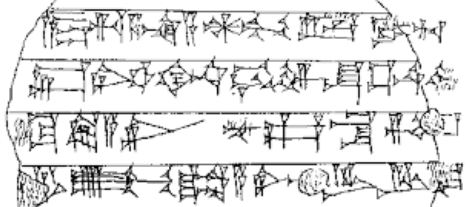 Sumerian proverb. Literal translation: poor man how-is lowly / mill edge-oven-of / garment-ripped-his not-excellent-will be / what-lost-his not-search for-will be. Sumerian proverb. Literal translation: poor man how-is lowly / mill edge-oven-of / garment-ripped-his not-excellent-will be / what-lost-his not-search for-will be.Morphed for better comprehension: How lowly is the poor man! / A mill (for him) (is) the edge of the oven; / His ripped garment will not be mended; / What he has lost will not be sought for! (Source.) 35 Proverb: A simple and concrete saying, popularly known and repeated, that expresses a truth based on common sense or the practical experience of humanity. (From Wikipedia. By that token, Sumerians were not wanting for common sense. Here are a few passed on by Kramer, but there are more where these come from. They were written down more than 3500 years ago and resumably been passed on orally long and long before. Just a few ought be suffice here: 36 We are doomed to die, let's spend, By and large, people are quite concerned about what their attire. Going back to ancient Sumer, what did people wear then? Well, not much to write home about until, that is, weaving was invented. That changed things drastically and, interestingly, ancient Sumerians wouldn't look any longer all that much out of place in modern society. Initially, men began to wear kilts, but later they wore clothing from the neck down. Materials used were flax and wool; flax for hot periods, wool when the weather was cooler. Sumerian women dressed in lengthy, close-fitting dresses down to their ankles. Their right arms and shoulders were usually bare. 38 Men were either clean shaven or had long hair and beards. Women wore their hair long, but usually braided it and wrapped it around their heads. Well-off Sumerians, men and women, wore jewelry as well; the weller-off, the more they wore. Bracelets, pendants, headdresses and necklaces were common. Their jewelry was often made of silver or gold, gemstones as well: lapis lazuli, but mostly carnelian, a reddish-orange gemstone. These types of accessories were especially worn during religious celebrations—except by the priestesses. They did not wear woven clothes at all. In the interest of upholding religious tradition, they kept on wearing animal hides. The oldest epic in the world, Gilgamesh, refers to temple harlots. Herodotus has some unfriendly gossip about them, but let's not get int that. 39 Bibliography
|
|
A substantial assortment of translated Sumerian stories is avalaible from ETCSL, here. * fn1 The discovery of artifacts (~2600 BCE) associated with Enmebaragesi of Kish, mentioned in the legends as the father of one of Gilgamesh's adversaries, has lent credibility to the historical existence of Gilgamesh. The epic has influenced both ancient and modern literature and culture, and themes from the Epic can be found in later biblical and classical literature. (Source.) * fn2 The Julian calendar assumes a 365-day year. Problem is that the year last just a little longer, consequently the calendar got badly out of step with the seasons. The Gregorian calendar makes a substantial improvement by inserting "leap years" of 366 days. Proposed in 1582, the calendar was adopted by the Roman Catholic European countries in that and the following years, in the Protestant parts of the Holy Roman Empire in 1700, and later still by England, Scotland and Ireland (1752). For further details, turn to this site. * fn3 |
--
| top of page |
|
Page maintenance:
Page format:monh xx, 2015
Story edit:
To be checked for timeliness:
¶ none
Reminders:
¶ none
Linkcheck: not done
XHTML verify: April 7, 2015
Backups: month. 25, 2011

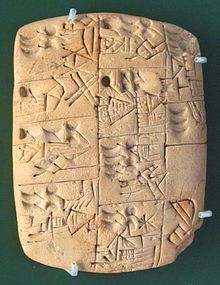 Early writing tablet recording the allocation of beer, 3100–3000 BCE. (
Early writing tablet recording the allocation of beer, 3100–3000 BCE. (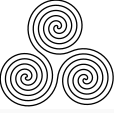 A modern rendering of the triple spiral. (
A modern rendering of the triple spiral. (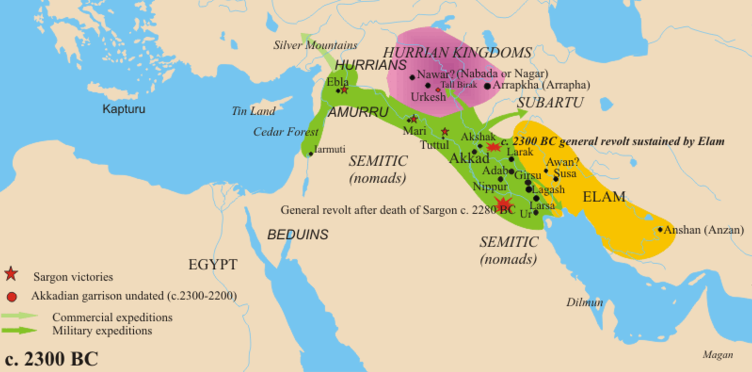 The Akkadian Empire (2334–2154). Sargon (or his scribes ensuring that history would be kind to him) claimed that the empire stretched from the Persian Gulf through modern-day Kuwait, Iraq, Jordan, Syria (possibly Lebanon) through the lower part of Asia Minor to the Mediterranean Sea and Cyprus. Dark green arrows indicate militairy expeditions; light gree, commercial exploration. (
The Akkadian Empire (2334–2154). Sargon (or his scribes ensuring that history would be kind to him) claimed that the empire stretched from the Persian Gulf through modern-day Kuwait, Iraq, Jordan, Syria (possibly Lebanon) through the lower part of Asia Minor to the Mediterranean Sea and Cyprus. Dark green arrows indicate militairy expeditions; light gree, commercial exploration. (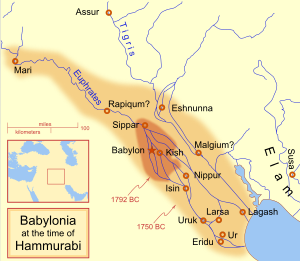 Babylonian territory. Dark brown when Hammurabi ascended, ~1792; light brown at the time of his death, 1750 (
Babylonian territory. Dark brown when Hammurabi ascended, ~1792; light brown at the time of his death, 1750 (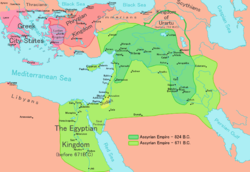 Neo-Assyrian Empire (dark green) and its expansions (light green). (
Neo-Assyrian Empire (dark green) and its expansions (light green). (